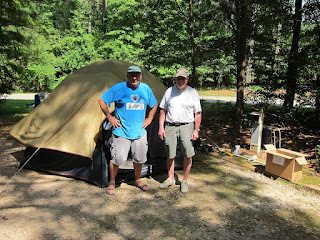Reference
The CMoy headphone amplifier details
Gain and DC offset measurements were made using two different rail voltages as follows:
Input signal: A sinewave at 1kHz with variable amplitude. Source impedance = 50ohms.
Load: 270ohms on each channel to (simplistically) simulate the Beyerdynamic DT880 audiophile headphones owned by my son.
Both channels showed the same results.
LED current = 1.43mA
With rail-to-rail voltage = 7.68V, DC current = 9.1mA. (Same w/wo the 270ohm loads connected). Thus DC power = 70mW.
Vgnd-Vplus = 3.77V. Vgnd-Vneg = -3.91V. Thus DC Offset = (7.68/2)-3.77=
70mV.
At the point of clipping on positive voltage swings Vp-p(out) =
4.6V. Vp-p(in) = 430mV.
Thus Vgain = 10.69. Headroom on the Vplus rail = |(4.6/2)-3.77|=1.47V.
P=(Vp-p)^2/8R = 4.6^2/(8*270)=
9.7mW.
Thus efficiency = 9.7/70 = 0.14.
With rail-to-rail voltage = 15.31V. DC current = 11mA. (Same w/wo the 270ohm loads connected). Thus DC power = 168mW.
Vgnd-Vplus = 7.59V. Vgnd-Vneg = -7.72V. Thus DC Offset = (15.31/2)-7.59=
65mV.
At the point of clipping on positive voltage swings Vp-p(out) =
10.9V. Vp-p(in) = 1V.
Thus Vgain = 10.9. Headroom on the Vplus rail = |(10.9/2)-7.59|=2.14V.
P=(Vp-p)^2/8R = 10.9^2/(8*270)=
55mW.
Thus efficiency = 55/168 = 0.33








































